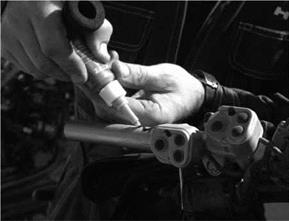Cyanoacrylates can be toughened by the addition of rubber particles. The standard methyl or ethyl cyanoacrylates can have poor impact strength and low peel strength but modified ethyl cyanoacrylates were developed in the mid 1980s that show superior peel strength and often high humidity resistance. The principle of toughening the adhesive is that the rubber particles minimise the propagation of cracks as the adhesive is subjected to high peel or cleavage loads. Figure 1.4 shows a high peel load situation. The diagram on the left shows a crack propagating through the adhesive bond line on a standard ethyl cyanoacrylate. On the right — hand side, the adhesive is toughened by the addition of rubber particles and so the crack only gets as far as the rubber particle and the stress is then dissipated and the crack has to reform only to meet another ‘crack arrester’. The resulting adhesive bond line is therefore considerably more resistant to peel and cleavage loads than a conventional cyanoacrylate. However, the toughened cyanoacrylates are slower curing than standard grades.
|
Figure 1.4 Toughened cyanoacrylates offer better resistance to peel loads due to the presence of rubber particles in the adhesive matrix |
|
Figure 1.5 Using a toughened cyanoacrylate to bond the rubber grip on to the handlebar of a trials motorcycle |
The rubber toughened cyanoacrylates are particularly well suited for rubber-to-metal bonding applications. In Figure 1.5 below, a toughened cyanoacrylate is used to bond the rubber grip onto the handlebars of a motorcycle. In this application, the benefit of using the rubber-toughened grade is that it is slower curing than a standard ethyl grade as, with a long engagement length and close fitting parts such as this, a standard cyanoacrylate would be too fast and it would not be possible to assemble the parts.
 26 августа, 2015
26 августа, 2015  Pokraskin
Pokraskin 

 Опубликовано в рубрике
Опубликовано в рубрике 